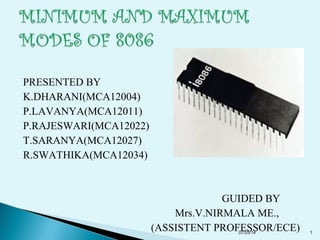
Minimum And Maximum Modes Of 80826
- 1. PRESENTED BY K.DHARANI(MCA12004) P.LAVANYA(MCA12011) P.RAJESWARI(MCA12022) T.SARANYA(MCA12027) R.SWATHIKA(MCA12034) GUIDED BY Mrs.V.NIRMALA ME., (ASSISTENT PROFESSOR/ECE)07/25/14 1
- 2. Microprocessor 8086 Features of 8086 Pin-diagram for 8086 Minimum and Maximum mode systems Hardware organization Applications of 8086 07/25/14 2
- 3. 07/25/14 3
- 5. 07/25/14 5
- 6. 07/25/14 6
- 7. 07/25/14 7
- 8. 07/25/14 8
- 9. 07/25/14 9
- 10. HLDA It is hold acknowledge active signal. It is also an output signals and works like 8085 microprocessor . HOLD It is the hold request signal which is used in DMA to hold the system. Request given to hold. 07/25/14 10
- 11. WR It indicates the performance of the processor by means of writing the memory or I/O operations. It act in low signal. M / IO It is the memory/input signal which is an O/P three state signals. It is useful in distinguishing the memory access from an I/O access. 07/25/14 11
- 12. DT/ R It is the data transmit/receive signal which is also the three state O/P. It is useful for controlling the data and low direction via transceiver. DEN Is the data transmit/receive signal which is also the three state O/P. It is useful for controlling the data and low direction via transceiver. It both data transmit and receives. 07/25/14 12
- 13. ALE Address Latch Enable It is useful in demultiplexing. INTA It is an output signal. It is associated with INTR signal used for aknowledgement of an interrupt by request. 07/25/14 13
- 14. Transceiver It works on behalf of the processor to transmit or receive the data between memory and the processor. Latches It is used to store the address that is supplied to memory or I/O devices during the current machine cycle. Clock generator The clock generator generates clock pluse for the crystal is connected. 07/25/14 14
- 15. MEMORY AND I/O DEVICES The temporary data are usually stored in RAM. It is used during execution of the program while the permanent data are stored in PROM. The I/O devices are used to connect the microprocessor with external I/P devices, which are used to get the data and output devices. It is used to send the data. 07/25/14 15
- 16. Advantages of Minimum Modes It is cheap. Microprocessor does itself generator I/O. Microprocessor does itself generator I/O control signal. 07/25/14 16
- 17. M/IO WR RD OPERATION 0 0 1 I/O write 0 1 0 I/O read 1 0 1 Memory write 1 1 0 Memory read 07/25/14 17
- 18. Mode Select MN/MX’ Interrupt interface 8086 MPU Power supply Vcc GND INTR _____ INTA _____ TEST NMI RESET HOLD HLDA Address / data bus AD0-AD15, A16/S3-A19/S6 ALE ____ BHE/S7 M/IO’ DT/R’ ___ RD ___ WR ____ DEN READY CLK DMA interface Memory/IO controls 07/25/14 18
- 19. Clock (CLK) : Input signal which synchronize the internal and external operations of the microprocessor. 8088 operates at two different speeds; -5MHz <-standard ports. -8MHz <- standard ports. 8086 Manufactured three speed: -5 MHz for standard 8086 -8 MHz for standard 8086-2 -10 MHz for standard 8086-1 07/25/14 19
- 20. The maximum mode signals are RQ/GT0 It is requested/grant access control signals is bidirectional in nature. LOCK It is the output 3-state signal used for the purpose of holding the operation S2-S0 S2-S0 are the output 32-state signal used for the purpose of bus cycle status. QS1,QS0 QS1,QS0 are the output signal used for the purpose of instruction queue status. 07/25/14 20
- 21. 8088 8086 Low / Even Bank High / Odd Bank Bank – select signals 07/25/14 21
- 22. BHE A0 SELECTION 0 0 Whole word(16 bit) 0 1 High byte to /from odd address 1 0 Low byte to /from even address 1 1 No selection 07/25/14 22
- 23. A word starting at ODD address : Misaligned The LSB is located at lower address in High Bank, ( Example : 00003(h) and 00004(h) Requires 2 bus cycles, where X+1 address in high bank is accessed during the first Bus cycle ( A0=1, BHE=0) and data is transferred using D8 to D15 In second bus cycle ( A0 = 0, BHE = 1 , data transferred via D0 – D7 ) The next two slides demonstrated this activity 07/25/14 23
- 24. Address bus A19 – A1 D15 – D8 D7 – D0 ____ BHE ( LOW ) X + 2X + 3 X + 1 X A0 (HIGH) First bus cycle 07/25/14 24
- 25. Address bus A19 – A1 D15 – D8 D7 – D0 ____ BHE ( HIGH ) X + 2X + 3 X + 1 X A0 (LOW) Second bus cycle 07/25/14 25
- 26. Idle State: No bus activity required Each is 1 clock period long Occurs when instruction queue is full or the MPU does not need to read/write to memory Wait State Triggered by events external to MPU Buffer full will trigger a wait state Triggered by READY pin Inserted between T3 and T4 07/25/14 26
- 27. It is used for various instruction set and interrupt systems also. They were a popular, early, microprocessor commonly embedded in washing machines and domestic appliances, to replace mechanical timers and interlocks. Home Appliances Air conditioner circuits Telephone communication circuits Fan Circuits 07/25/14 27
- 28. Induction cooker circuits Lamp/ Lantern circuits Refrigerator circuits Television circuits Agricultural Automation Circuits Anti-harm circuits Cultivation circuits General circuits Electronic Maintenance circuits Remote control based circuits Networking circuits Telephone communication circuits 07/25/14 28
- 29. So for we explained What is mean by microprocessor Features of microprocessor Pin diagram of 8086 Minimum mode system Maximum mode system Applications of microprocessor 07/25/14 29
- 30. Advanced Microprocessors And Peripherals- AK RAY & KM BHURCHANDI WEBSITES http://microprocessorforyou.blogspot.in/2011/12/feat ures-of-8086.html http://8085projects.info/page/agricultural- automation-circuits.html 07/25/14 30
- 31. ““SUCCESS CANNOT BE ASSURED.SUCCESS CANNOT BE ASSURED. IT MUST BE ATTAINED”.IT MUST BE ATTAINED”. 07/25/14 31